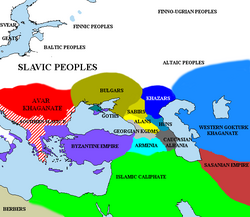| Irbis | |
|---|---|
| House | Ashina |
| Religion | Tengrism |

Irbis (fl. 650 or 652) [1] was according to a number of Russian sources the founder of the Khazar Khaganate. [2] The Khazars traced their origin to the Turkic Ashina clan who also founded the Onok Khaganate and Turkic Khaganate in Central Asia. [3]
Peter Golden notes that Chinese and Arabic reports are almost identical, making the connection a strong one, and conjectures that the Khazar leader may have been Irbis Seguy, who lost power or was killed around 651. [4]
